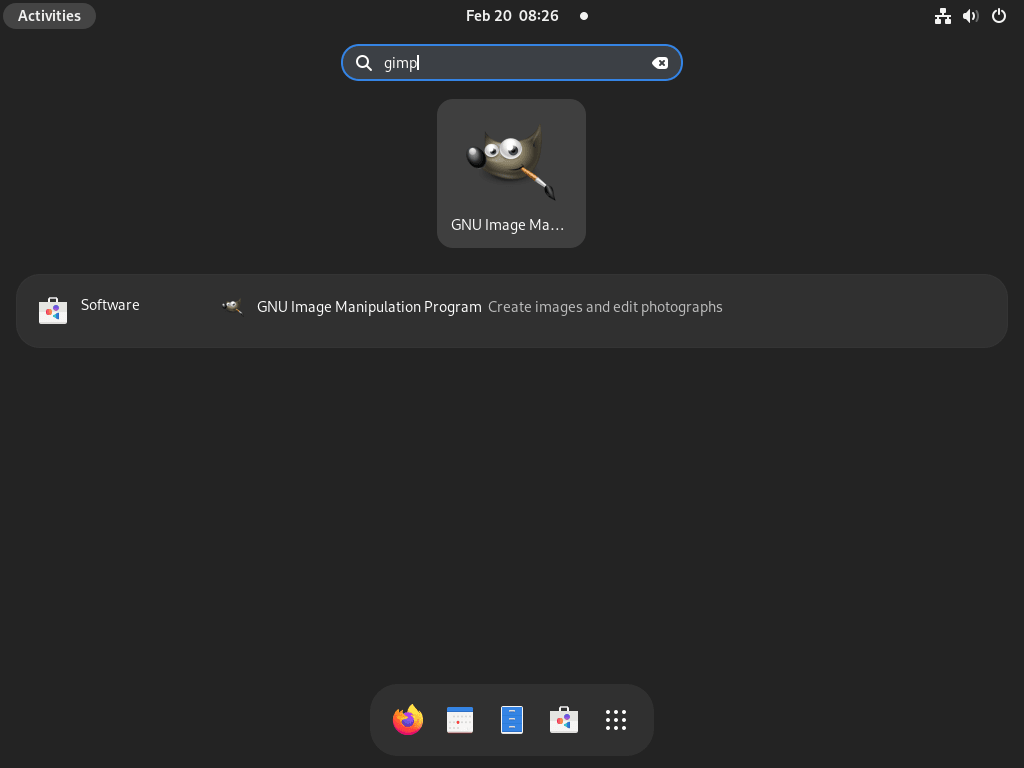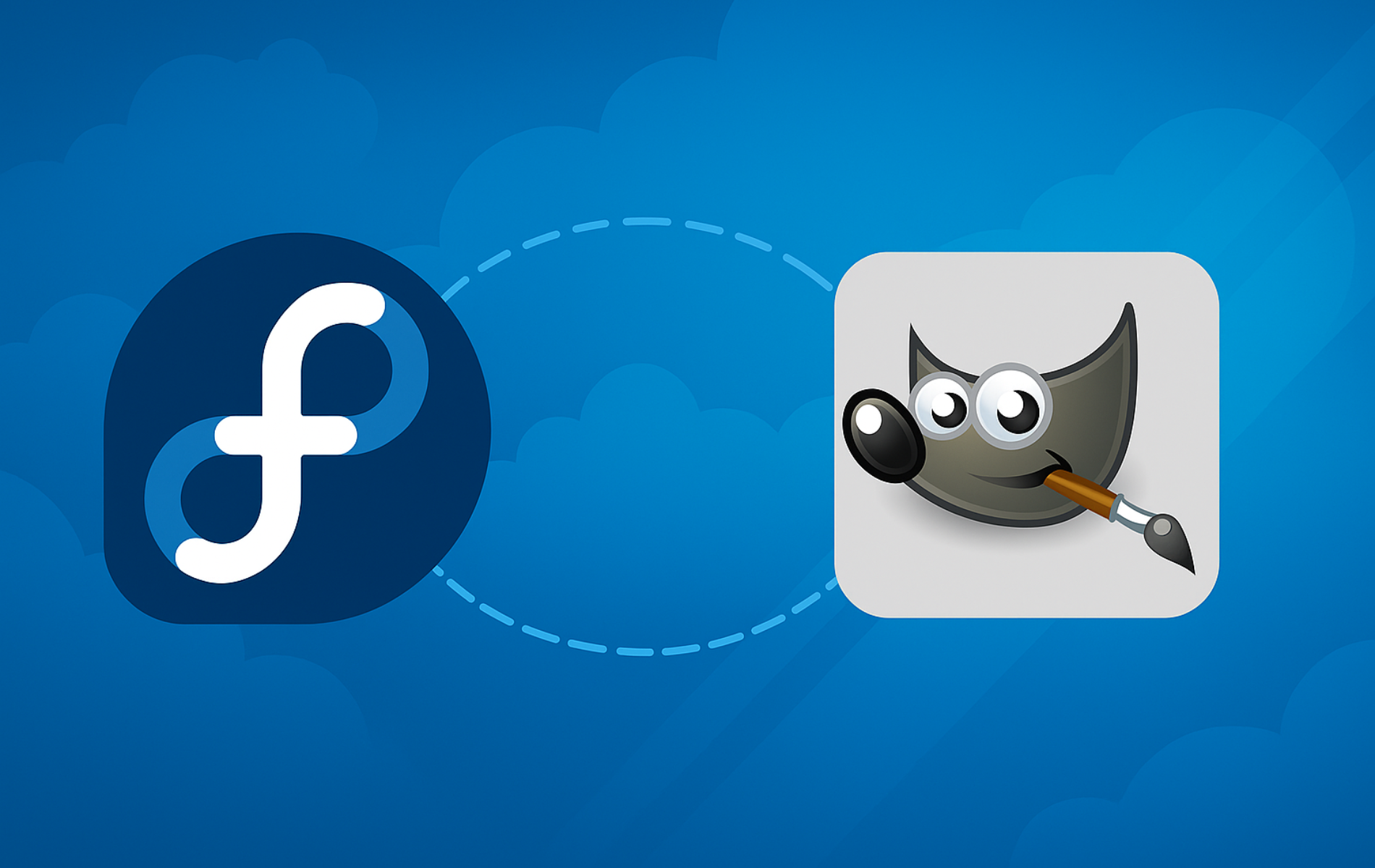GIMP (GNU Image Manipulation Program) is an open-source image editor that handles photo restoration, web graphic creation, thumbnail design, and complex multi-layer compositions. Whether you need to remove backgrounds from product photos, design YouTube thumbnails with custom text overlays, or restore old family photographs with spot healing and color correction, GIMP provides the layers, masks, filters, and selection tools to accomplish it. By the end of this guide, you will have a working GIMP installation verified through version checks, understand when to choose the distribution package versus the Flatpak build, and know how to launch the application from both the terminal and the desktop menu.
Fedora offers two installation paths: the official repository provides stable system integration with automatic updates through DNF, while the Flatpak option from Flathub delivers a sandboxed environment that sometimes ships newer releases slightly ahead of the distribution package. This guide covers both approaches with verification steps so you can select the method that matches your update preferences and system architecture.
Choose Your GIMP Installation Method
Both methods install the same application, but they differ in update frequency, system integration, and storage location. The table below summarizes the key differences:
| Method | Channel | Updates | Best For |
|---|---|---|---|
| Fedora Repository | Official repos via DNF | Synced with Fedora release cycle | Users who prefer system-integrated packages with automatic updates |
| Flatpak (Flathub) | Flathub stable | Independent of Fedora releases | Users who want sandboxed installs or slightly newer versions |
For most users, the Fedora repository method provides the simplest experience with seamless DNF updates. Choose Flatpak if you prefer application sandboxing or need a version that has not yet reached the Fedora repositories.
Install GIMP from Fedora Repository
Update System Packages
First, update your Fedora system’s packages to mitigate compatibility issues during the GIMP installation:
sudo dnf upgrade --refreshThis command refreshes the repository metadata and upgrades any outdated packages. You should see output similar to:
Fedora 43 - x86_64 100% [=================] Fedora 43 - x86_64 - Updates 100% [=================] Dependencies resolved. Nothing to do. Complete!
Install GIMP Package
Fedora’s default repositories offer a stable and secure option for installing GIMP. The version is typically current, though Flathub may receive micro-releases slightly earlier.
Install GIMP by running:
sudo dnf install gimpThe installation completes successfully when you see:
Installed: gimp-3.0.6-1.fc43.x86_64 Complete!
If you plan to develop GIMP plugins, write Script-Fu extensions, or compile third-party add-ons, install the development headers:
sudo dnf install gimp-develMost users do not need this package for standard photo editing tasks.
Verify GIMP Installation
After installation, verify that GIMP installed correctly by checking the version:
gimp --versionYou should see output showing the installed version:
GNU Image Manipulation Program version 3.0.6
For additional DNF package management examples, see DNF install examples on Fedora. To speed up repository downloads, consider increasing DNF speed on Fedora.
Version numbers change with repository updates. Any current stable release confirms successful installation.
Install GIMP via Flatpak (Flathub)
The second available option for installing GIMP uses the Flatpak package manager, which Fedora includes by default on workstation installations. The primary advantage of using Flatpaks is that they can sometimes be a version or two ahead of what is available on Fedora, depending on the release cycle and updates of the software and the Flatpak package maintainer.
Verify Flatpak Installation on Fedora
Flatpak, pre-installed on Fedora, provides a sandboxed environment that often offers more recent versions of applications than those available through the DNF repositories. To ensure Flatpak works correctly on your system, reinstall or confirm it with:
sudo dnf install flatpakThis command reinstalls Flatpak if you previously removed it and sets up your system to work with Flatpak packages.
Add Flathub Repository
Add Flathub as a source for Flatpak applications (if not already added):
sudo flatpak remote-add --if-not-exists flathub https://flathub.org/repo/flathub.flatpakrepoConfirm the Flathub remote is enabled:
flatpak remotes --show-detailsName Options Title URL flathub system Flathub https://flathub.org/repo/flathub.flatpakrepo
This configures your system to fetch applications from Flathub, expanding your access to a broader range of software.
Install GIMP via Flatpak Command
With Flatpak and Flathub set up, you can now install GIMP. Run the following to commence installation:
flatpak install flathub org.gimp.GIMPVerify GIMP Flatpak Installation
After installation, verify the Flatpak build by checking the version:
flatpak run org.gimp.GIMP --versionGNU Image Manipulation Program version 3.0.6
Version numbers vary with Flathub updates. Any current stable 3.x release confirms a successful installation.
Troubleshooting Flatpak Installation Errors
If the Flatpak installation fails, you may see an error like:
error: Unable to load summary from remote flathub: Can't fetch summary from disabled remote 'flathub'
This indicates the Flathub remote is disabled. Enable it with:
flatpak remote-modify --enable flathubVerify the remote is now enabled:
flatpak remotesName Options flathub system
Once enabled, retry the GIMP installation command.
Launch GIMP User Interface
With GIMP installed on your system, you can launch the application in two common ways.
Launch GIMP from Terminal
First, launch the application with the following command in an open terminal:
gimpAlternatively, if you installed GIMP via Flatpak, launch the application from the terminal with:
flatpak run org.gimp.GIMPLaunch GIMP from Applications Menu
If you do not have an open terminal, the most common way to launch the application is by using the application menu. You can find the application icon with the following navigation path:
Activities > Show Applications > GNU Image Manipulation Program

Remove GIMP (Optional)
If you no longer require GIMP on your Fedora Linux system, you can use the following commands to remove it, depending on the original installation method:
For installations of GIMP using the DNF package manager, run:
sudo dnf remove gimpAlternatively, for installations of GIMP using Flatpak:
The
--delete-dataflag removes the application and all user data including custom brushes, saved settings, tool presets, and export history. Back up any important customizations from~/.var/app/org.gimp.GIMP/before proceeding.
flatpak remove --delete-data org.gimp.GIMPTo remove user configuration and cache files for the DNF installation, delete the local directories:
These directories contain all GIMP preferences, custom brushes, patterns, tool presets, keyboard shortcuts, export history, and cached data. Removing them is permanent. Export any custom assets before running this command.
rm -rf ~/.config/GIMP ~/.cache/GIMPConclusion
GIMP is now installed and verified on your Fedora system with the version check confirming functionality. Whether you chose the distribution package for stable system integration or the Flatpak build for newer releases, you can launch the editor from the terminal or desktop menu and begin working with layers, masks, and filters for photo editing and graphic design. Consider enabling RPM Fusion on Fedora for additional codec libraries that improve compatibility with formats like HEIF and RAW camera files, and set up DNF Automatic to keep GIMP and other packages current with minimal manual intervention.


